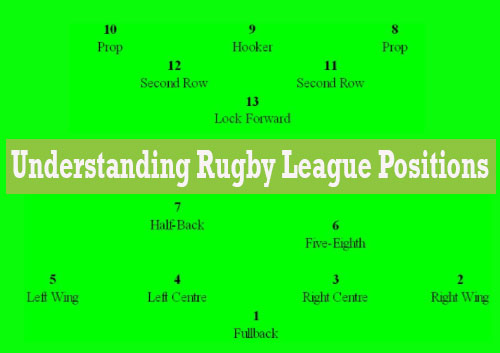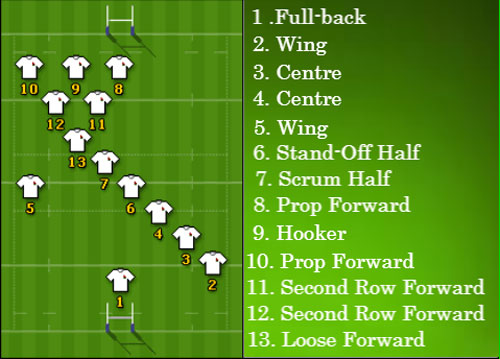
Hi Guys… Are you a ruby fan? Do you know there are positions in Rugby League? If you are searching for these questions, then you are on the right page. Here in this post, we are providing you complete details of Rugby League Positions.

Rugby is a famous sport and it is watched by many people across the world. Rugby League was founded on September 7, 1895. A rugby league football consists of 13 players on the field, with 4 substitutes on the bench. The players are divided into two general categories: “forwards” and “backs”. The rules of the game apply to all players in the same way.
Forwards in the game are generally chosen for their size and strength. Forwards in the game are expected to run with the ball and attack, and to make many tackles. They are required to do a lot of hard work such as making openings for the backs and gaining meters in field position. Backs in the game are usually smaller and faster, though a big player who can run can be of advantage in the backs. The roles of the backs require speed and ball-playing skills, rather than just strength, to take advantage of the field position gained by the forwards.
Rugby League Positions

Names and Numbering
The numbering of positions in rugby is standardized. The starting side normally wears the numbers corresponding to their positions, only changing in case of substitutions and position shifts during the game. In some competitions, such as Super League, players are issued with a squad number to use all season, no matter what positions they play in.
The positions and numbers are defined by the game’s laws as:
Backs
1 .Full back
- Right Wing Threequarter
3 .Right Centre Threequarter
- Left Centre Threequarter
5 .Right Centre Threequarter
Halves
- Stand-Off Half or Five-Eighth
7 . Scrum Half or Half-Back
Forwards
- Prop
- Hooker
- Prop
- Second Row Forward
- Second Row Forward
- Loose Forward or Lock Forward
Backs
Generally the back line of the game consists of smaller and faster players. The term outside backs is sometimes referring to the centers and wings, while the halves refer to the halfback and five-eighth.
Fullback
This position is numbered 1, it calls for all-around ball-playing ability and speed. The fullback is the last line of defense, standing behind the main line of defenders. Fullbacks must be able to chase and tackle any player who breaks the first line of defense, and must be able to catch kicks made by the attacking side. Their role in attack is usually as a support player but also come into the line to create an extra man in attack.
The Three-quarters
The three-quarters are also known as outside backs and consist of the wings and centers. The three-quarters are placed closer to the edges of the field.
Wing
They are also known as wingers. There are actually only 2 wingers in a rugby league team, they are numbered 2 and 5, and are positioned around the fullback. The wingers are generally among the strongest players in a team, with the muscle to defend the fullback. They generally are among the strongest players in a team, with the muscle to defend the fullback. The wingers have to be able to kill someone if they have to.
Center
In rugby there are 2 centers, right and left and they are numbered 3 and 4 respectively. They are positioned outside the halves and inside the wings. They are usually medium sized. Or, as is now common place are large, fast with good footwork and an offload to pass to their wingers.
The Halves
There are 2 half backs – the stand-off half back numbered 6 and the scrum half back, numbered 7. They are positioned more centrally in attack, near the forwards, they direct the ball in attack and are usually 2 of their team’s main decision-makers.
Stand-off
The stand-off or five-eight is numbered 6 and is usually responsible for directing the ball to the rest of the tam in attack and is often a strong kicker. A good stand-off in a rugby should be a quick thinker and to be able to direct his team around the park.
Scrum half
The scrum half is numbered 7 and is also known as half back. This position is usually involved in directing his team’s play and is likely to be a very good passer. This position is sometimes also called as first receiver because half backs are often positioned so as to be the first to receive the football from the dummy-half after a play-the-ball. Scrum halves are often short and fast over a short distance and should also be very capable handlers of the ball.
Forwards
In rugby league forward pack consists of players and they tend to be bigger and stronger than backs, generally forwards depend more on their strength to fulfill their roles than play-making skills. The forward players also form and contest scrums, while the backs stay out of them.
The Front Row
In rugby the front row of the scrum includes the hooker with the 2 props on either side. All three may be referred to as front-rowers, but this team is most commonly just used for prop forwards.
Hooker
The hooker is numbered 9, packs in the middle of the scrum’s front row. A hooker is, strong and fast. Good hookers are fast from the play the ball which always the team to get on the front foot. Usually it is the hooker’s responsibility to operate at the dummy half position, starting the play by passing the ball to a team mate or by running himself. This can lead to a penalty, good field position or even a try.
Prop
There are two props, numbered 8 and 10, who pack in to the front row of the scrum on either side of the hooker. The props are often the two heaviest players on a team. Primarily, in attack their size and strength are utilized for running directly into the defensive line, as a kind of battering ram to simply gain meters. Similarly, props are relied upon to defend against such running from the opposition’s forwards.
The Back Row
The back row is made up by three forwards of the scrum. They include 2 second-rowers and a loose forward or lock forward. These all 3 may be referred to as back-rowers.
Second-row Forward
These are numbers 11 and 12, and they make up the second row of the scrum. They support the front rowers while attacking. They are either used as wide-running forwards to help create room for the quicker men due to their size or as endurance athletes who can play an entire game at a consistent level in the middle of the field. The second-row forward are nicknamed as tackling machines.
Loose Forward
They are numbered 13 and they are also known as lock pads behind the two second-rows in the scrum. From an attacking scrum they will sometimes pick the ball up themselves and run or pass. Many locks nowadays are used as a third ball player due to their ball playing skills as well as their size which they can use to break through the defense. It is customary in the NRL for each team to have a member of the back-row who can ball-play. Some notable professional locks have also played at five-eighth, as the roles can be similar.
Interchange
A maximum of 4 interchange players are allowed, who start the game on their team’s bench. It is mandatory to see 3 forwards and either a utility or replacement hooker on the bench however not all teams do this. The rules governing if and when a replacement can be used have varied over the history of the game; currently they may replace any injured player or be used for a tactical substitution by their coach. Under the rules of the National Rugby League 10 interchanges are permitted per team, every game. However, if a player is deemed to have been injured due to foul play then the team is given a free interchange.
So, this is all about Rugby League positions. If you like this post, please share on social media sites like Facebook, Twitter, Google+, WhatsApp and Pinterest. Thank you for watching our site LeagueTeamUpdates.
send me notes about rugby league